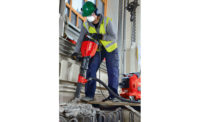New Silica Dust Rule Will Save Lives, OSHA Says
A final rule issued on March 24 by the Occupational Safety and Health Administration reduces the permissible exposure limit (PEL) for respirable crystalline silica. The measure aims to protect workers from lung cancer, silicosis, chronic obstructive pulmonary disease and kidney disease.
The rule is controversial but long awaited by unions, which contend that too many workers become sick or die each year as a result of exposure to silica dust on construction sites.
But construction industry groups say the required reductions are not achievable using existing technologies.
The rule, which goes into effect on June 23, 2016, reduces the PEL for silica dust at construction sites to 50 micrograms per cu meter of air, averaged over an eight-hour shift. To achieve the reductions, employers will be required to use engineering controls, such as water or ventilation, and provide respirators when engineering controls do not effectively limit exposures.
OSHA estimates the rule will save more than 600 lives and prevent more than 900 new cases of silicosis each year. The agency also claims the rule will provide net annual benefits of about $7.7 billion. OSHA estimates that, currently, more than 840,000 construction workers are exposed to silica levels that exceed the new PEL. Exposure to respirable crystalline silica can occur during common construction activities, such as using masonry saws, grinders, drills, jackhammers and handheld powered chipping tools.
Although the rule goes into effect on June 23, employers will have until June 2017 to implement the new controls required to limit exposure.
Unions were quick to praise the rule. Terry O’Sullivan, general president of the Laborers International Union of North America (LIUNA), said in a statement, “The new OSHA standard for silica is a welcome and long overdue step toward safer jobsites for the many million of workers who suffer from its deadly impacts.”
Union groups, such as LIUNA and the North American Building Trades Unions, have long fought for more stringent limits on exposure to silica dust.
But employer groups say the rule is not currently achievable. Stephen Sandherr, CEO of the Associated General Contractors of America, said in a statement, "Instead of crafting new and innovative ways to get more firms to comply with the current silica standard, which we know would save even more workers each year, administration officials appear to have, instead, opted to set a new standard that is well beyond the capabilities of current air-filtration and dust-removal technologies. Wishing firms could meet this new but unattainable standard will undoubtedly deliver many positive headlines for the administration, but it will be all but impossible for most construction firms to comply with this new rule.”


